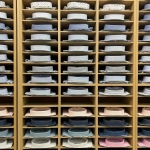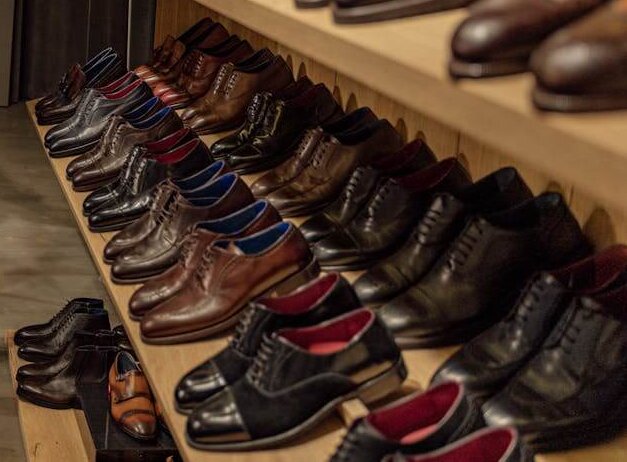 Source: Pexels
Source: PexelsBlisters, pain, and discomfort? Learn how I broke in my new shoes fast—within three days. Discover effective methods using what you have at hand.
The sole of one of my old but beloved Hush Puppies broke a few weeks ago, rendering them unwearable—you’ll know them if you’ve read my post “How to Shine Your Shoes.” To make matters worse, I discovered there was nowhere to buy new ones in the part of the world I currently find myself. So, for the first time in years, I had to purchase an unfamiliar brand and ended up with a blister on the back of my right heel.
It was probably my own fault. When trying on, I didn’t concentrate too much on the back of the shoes; it’s the front that usually causes issues. Since childhood, I’ve had a persistent corn between the fourth and fifth toes of my right foot.
Apart from that, I didn’t take any precautions. Knowing that new shoes can be problematic, it’s a good idea to prepare for the worst before wearing.
Be Prepared to Break In a New Pair of Shoes
In summer, I sometimes slip into a pair of Sketchers. But I’ve otherwise worn the same Hush Puppies day in, day out for years. They were inconspicuous and seemed to match every outfit—for me, that means jeans and chinos for work, and a couple of well-worn suits for worship. Above all, they were comfortable.
As for my Sketchers—they fit like bedroom slippers. But being textile, they’re only suitable for summer. They’re also slippery in the wet, making them impractical (if not dangerous) during unpredictable autumn weather.
Not having a sturdy second pair to fall back on meant I couldn’t break in my new shoes gradually.
To make matters worse, I had practically nothing at hand to mitigate problems should they arise. It was only after the blister appeared that I ordered stretching spray and heel cushions from Amazon: a case of closing the stable door after the horse had bolted.
The only things I coincidentally did right was to buy the shoes later in the day when feet are larger due to fluid build-up from standing and walking. And I applied leather conditioner, but only to add a protective layer in case of rain. I’ve since learned that this can help during the softening process.
Let’s take a closer look at what I did and what I should have done.
Break In Your Shoes With Gradual Wear
The morning after buying the shoes—a semi-casual Derby in black—I wore them to court where I was appearing as a witness in a civil lawsuit. I then went to work, which involves a lot of walking to the coffee machine and photocopier. My feet survived unscathed. This indicated a good fit.
But while heading for the subway the next morning, I noticed some rubbing at the heel. By the time I arrived at the office, I could barely walk.
This would not have happened had I been able to wear the shoes for just a couple of hours each day at home, at best with thick socks. To speed things up, this is when I should have used the stretching spray.
But we’re all wiser in hindsight.
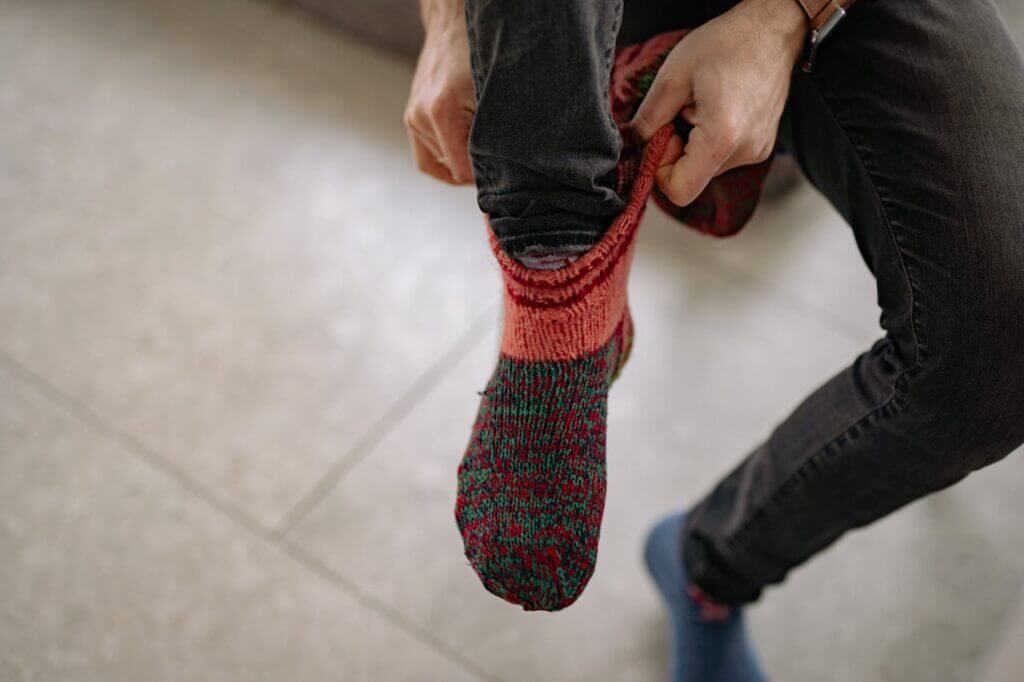
Emergency Blister Fix: Fold Down the Back
So, there I was at the office suffering excruciating pain with every step. My biggest worry was the coffee machine, which was some distance away.
A Band-Aid—the most obvious thing—offered no relief.
Nor did a wad of tissues stuffed into my sock.
Nor loosening the laces, which eases pressure on all parts of the foot—clearly not an option if you’ve bought slip-ons.
Since nothing worked, all I could do was fold down the back of the shoe and wear it as a sort of mule, which enabled me to get around painlessly. I even managed to do some grocery shopping on the way home.
But these were Derbies. Because they’re not supposed to appear too stiff, they’re quite forgiving. In fact, it probably aided the break-in process; by the time I arrived home, the leather at the back of the shoe had softened somewhat. But what if it had been dress shoes? Folding down the back would have permanently ruined the silhouette and compromised texture. Imagine the disaster it would be for patent leather.
Considering the level of pain, I’d have done exactly the same, regardless of damage.
Blister Bandages
While out shopping, I bought some blister bandages. Luckily, it was a Friday, meaning I had the whole weekend to recover. To make things even easier, I skipped worship for that week and stayed home.
But had I been forced to go out, blister bandages would have relieved the pain due to their gel padding.
Using hydrocolloid technology, they provide a perfect environment for healing as well as protection from dirt and bacteria.
By Monday morning, my blister was no longer noticeable.
Heel Cushions
Due to Amazon’s Prime Delivery, my heel cushions arrived on Saturday, allowing me to insert them into my new shoes on Monday morning to prevent further blisters.
Heel cushions are sometimes called “heel pads” or “heel cups.” They’re self-adhesive inserts made of silicone. Fitting into the back of the shoe, they create a barrier between the skin and the heel counter to avoid rubbing.
Don’t wait until you already have a blister; use them as a precautionary measure while breaking in your shoes.
Moisture-Wicking Socks
Dampness worsens friction and softens the skin, which causes blisters.
Moisture-wicking socks keep feet dry and reduce friction, making them one of the most effective preventive measures.
They work by pulling sweat away from the skin and dispersing it so that it can evaporate.
Stretching Spray for All Foot Areas
My stretching spray also arrived Saturday morning.
This softens the leather fibers so they can stretch under pressure.
It helps not only for rigid backs, but for an uncomfortable toe box or constrictive instep.
To use, spray the inside of the shoe on tight-fitting areas before wear. Start doing this during the previously mentioned gradual break-in process while wearing thick socks.
I chose a different method (which I’ll come to in a moment) since my foot was already injured and because I didn’t have a shoe stretcher.
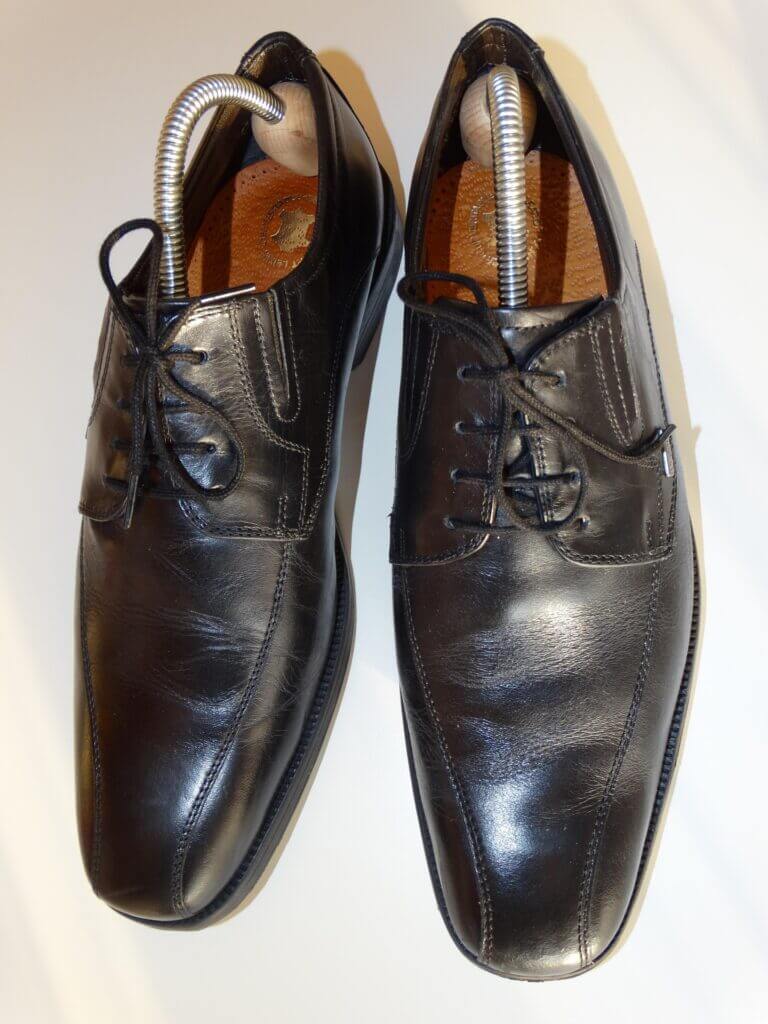
Break In with a Shoe Stretcher
I used to think a shoe stretcher and a shoe tree were one and the same. They’re not.
A shoe tree does not stretch; it preserves shape and prevents wrinkling across the instep. If made of cedar, it also absorbs moisture and odor.
A shoe stretcher, on the other hand, is designed to expand fit, relieving pressure points and easing break‑in. It can lengthen and widen, or target specific areas like corns and bunions.
It works best when paired with stretcher spray.
I’ve searched for shoe stretchers on Amazon, where “tree” and “stretcher” are often used interchangeably. They’re very affordable, though I’ve yet to invest in one.
Breaking In Without a Shoe Stretcher
The Thick Sock and Hairdryer Method
In spite of being bald, I still keep a hairdryer, but for DIY purposes. I used it while applying self-adhesive wall coverings.
Now, coupled with a pair of thick socks, it was going to help me break in my new shoes.
On a medium heat setting, I moved the dryer over the back of the shoe to soften and mold the leather. To prevent drying it out, I limited the process to a few minutes in 30-second intervals. Apply this to any part of the shoe that causes discomfort. For the toe and instep, gently flexing the foot aids stretching.
I chose this method because I didn’t want to walk in the shoe and risk worsening my blister.
This is the best way to quickly break in plastic or synthetic shoes.
The Ziploc Freezer Trick
I wouldn’t attempt this on leather shoes, which may suffer water damage or become brittle and cracked due to the cold. But it does work for plastic and other synthetic shoes.
Half-fill a Ziploc bag with water, insert into the shoe, and place in the freezer. Because water expands as it freezes, it gently stretches the shoe.
My new shoes now fit like a glove.
But I’ve learned from the ordeal and bought a second pair of sturdy shoes that I can fall back on. Apart from that, rotating shoes is part of proper foot care: it prevents pressure from building in the same places and extends the life of the footwear.
© 2025 J. Richardson
Related Posts
Disclaimer
The information provided by The Neat and Tidy Man (“we,” “us,” or “our”) on theneatandtidyman.com (the “site”) is for general informational purposes only. While we endeavor to keep the information up to date and correct, we make no representation or warranty of any kind, express or implied, regarding the completeness, accuracy, reliability, suitability, adequacy, validity, or availability of any information on the site. Under no circumstance shall we have any liability to you for any loss or damage of any kind incurred as a result of the use of the site or reliance on any information provided on the site. Your use of the site and your reliance on any information on the site is solely at your own risk.

